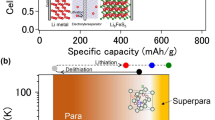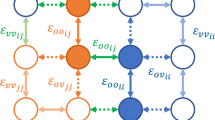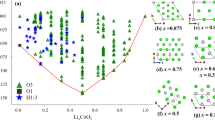Abstract
Despite many years of experimental searches for a first-order Mott transition in crystalline-doped semiconductors, none have been found. Extensive experimental work has characterized a first-order metal–insulator transition in LixCoO2, the classic material for rechargeable Li batteries, with a metallic state for x < 0.75 and insulating for x > 0.95. Using density functional theory calculations on large supercells, we identify the mechanism of this hereto anomalous metal–insulator transition as a Mott transition of impurities. Density functional theory demonstrates that for dilute Li-vacancy concentrations, the vacancy binds a hole and forms impurity states yielding a Mott insulator. The unique feature of LixCoO2 as compared with traditional doped semiconductors, such as Si:P, is the high mobility of the Li vacancies, which allows them to rearrange into two distinct phases at the temperature of the metal–insulator transition.
This is a preview of subscription content, access via your institution
Access options
Subscribe to this journal
Receive 12 print issues and online access
$259.00 per year
only $21.58 per issue
Buy this article
- Purchase on Springer Link
- Instant access to full article PDF
Prices may be subject to local taxes which are calculated during checkout




Similar content being viewed by others
References
Takada, K. et al. Superconductivity in two-dimensional CoO2 layers. Nature 422, 53–55 (2003).
Terasaki, I., Sasago, Y. & Uchinokura, K. Large thermoelectric power in NaCo2O4 single crystals. Phys. Rev. B 56, 12685–12687 (1997).
Van der Ven, A., Aydinol, M.K., Ceder, G., Kresse, G. & Hafner, J. First-principles investigation of phase stability in LixCoO2 . Phys. Rev. B 58, 2975–2987 (1998).
Van der Ven, A., Aydinol, M.K. & Ceder, G. First-principles evidence for stage ordering in LixCoO2 . J. Electrochem. Soc. 145, 2149–2155 (1998).
Carlier, D., Van der Ven, A., Delmas, C. & Ceder, G. First-principles investigation of phase stability in the O-2-LiCoO2 system. Chem. Mater. 15, 2651–2660 (2003).
Chen, Z.H., Lu, Z.H. & Dahn, J.R. Staging phase transitions in LixCoO2 . J. Electrochem. Soc. 149, A1604–A1609 (2002).
Gabrisch, H., Yazami, R. & Fultz, B. The character of dislocations in LiCoO2 . Electrochem. Solid State Lett. 5, A111–A114 (2002).
Edwards, P.P., Rao, C.N.R. & Mott, N.F. Metal-insulator Transitions Revisited (Taylor & Francis, London, UK; Bristol, Pennsylvania, USA, 1995).
Edwards, P.P. & Rao, C.N.R. The Metallic and Nonmetallic States Of Matter (Taylor & Francis, London; Philadelphia, 1985).
Graetz, J. et al. Electronic structure of chemically-delithiated LiCoO2 studied by electron energy-loss spectrometry. J. Phys. Chem. B 106, 1286–1289 (2002).
Reimers, J.N. & Dahn, J.R. Electrochemical and in situ X-ray-diffraction studies of lithium intercalation in LixCoO2 . J. Electrochem. Soc. 139, 2091–2097 (1992).
Ohzuku, T. & Ueda, A. Solid-state redox reactions of LixCoO2 (R3macr;m) for 4 volt secondary lithium cells. J. Electrochem. Soc. 141, 2972–2977 (1994).
Shao-Horn, Y., Levasseur, S., Weill, F. & Delmas, C. Probing lithium and vacancy ordering in O3 layered LixCoO2 (x≈0.5). An electron diffraction study. J. Electrochem. Soc. 150, A366–A373 (2003).
Amatucci, G.G., Tarascon, J.M. & Klein, L.C. CoO2, the end member of the LixCoO2 solid solution. J. Electrochem. Soc. 143, 1114–1123 (1996).
Menetrier, M., Saadoune, I., Levasseur, S. & Delmas, C. The insulator-metal transition upon lithium deintercalation from LiCoO2: electronic properties and Li-7 NMR study. J. Mater. Chem. 9, 1135–1140 (1999).
Molenda, J., Stoklosa, A. & Bak, T. Modification in the electronic-structure of cobalt bronze LixCoO2 and the resulting electrochemical properties. Solid State Ionics 36, 53–58 (1989).
Imanishi, N., Fujiyoshi, M., Takeda, Y., Yamamoto, O. & Tabuchi, M. Preparation and Li-7-NMR study of chemically delithiated Li1−xCoO2 (0 < x < 0.5). Solid State Ionics 118, 121–128 (1999).
Anderson, P.W. Absence of diffusion in certain random lattices. Phys. Rev. 109, 1492 (1958).
Kittel, C. Introduction to Solid State Physics (Wiley, New York, 1996).
Kresse, G. & Furthmuller, J. Efficiency of ab-initio total energy calculations for metals and semiconductors using a plane-wave basis set. Comp. Mater. Sci. 6, 15–50 (1996).
Kresse, G. & Furthmuller, J. Efficient iterative schemes for ab initio total-energy calculations using a plane-wave basis set. Phys. Rev. B 54, 11169–11186 (1996).
Kresse, G. & Joubert, D. From ultrasoft pseudopotentials to the projector augmented-wave method. Phys. Rev. B 59, 1758–1775 (1999).
Blochl, P.E. Projector augmented-wave method. Phys. Rev. B 50, 17953–17979 (1994).
Aydinol, M.K., Kohan, A.F., Ceder, G., Cho, K. & Joannopoulos, J. Ab initio study of lithium intercalation in metal oxides and metal dichalcogenides. Phys. Rev. B 56, 1354–1365 (1997).
Wolverton, C. & Zunger, A. First-principles prediction of vacancy order-disorder and intercalation battery voltages in LixCoO2 . Phys. Rev. Lett. 81, 606–609 (1998).
Marianetti, C.A., Kotliar, G. & Ceder, G. Role of hybridization in NaxCoO2 and the effect of hydration. Phys. Rev. Lett. 92, 196405 (2004).
Hettler, M.H., Mukherjee, M., Jarrell, M. & Krishnamurthy, H.R. Dynamical cluster approximation: Nonlocal dynamics of correlated electron systems. Phys. Rev. B 61, 12739–12756 (2000).
Biroli, G. & Kotliar, G. Cluster methods for strongly correlated electron systems. Phys. Rev. B 65 (2002).
Biermann, S., Aryasetiawan, F. & Georges, A. First-principles approach to the electronic structure of strongly correlated systems: Combining the GW approximation and dynamical mean-field theory. Phys. Rev. Lett. 90 (2003).
Sun, P. & Kotliar, G. Extended dynamical mean-field theory and GW method. Phys. Rev. B 66 (2002).
Dobrosavljevic, V., Pastor, A.A. & Nikolic, B.K. Typical medium theory of Anderson localization: A local order parameter approach to strong-disorder effects. Europhys. Lett. 62, 76–82 (2003).
Mott, N.F. On the transition to metallic conduction in semiconductors. Canad. J. Phys. 34, 1356 (1956).
Mott, N.F. Metal-Insulator Transitions (Taylor & Francis; Barnes & Noble Books, London, New York, 1974).
Acknowledgements
This research was supported with funding from the Department of Energy Basic Energy Science contract DE-F602-96ER45571, the National Science Foundation (NSF) Materials Research Science and Engineering Center program, and NSF contract DMR-0096462. We also gratefully acknowledge computing resources from the National Partnership for Advanced Computational Infrastructure.
Author information
Authors and Affiliations
Corresponding author
Ethics declarations
Competing interests
The authors declare no competing financial interests.
Rights and permissions
About this article
Cite this article
Marianetti, C., Kotliar, G. & Ceder, G. A first-order Mott transition in LixCoO2. Nature Mater 3, 627–631 (2004). https://doi.org/10.1038/nmat1178
Received:
Accepted:
Published:
Issue Date:
DOI: https://doi.org/10.1038/nmat1178
This article is cited by
-
Li iontronics in single-crystalline T-Nb2O5 thin films with vertical ionic transport channels
Nature Materials (2023)
-
Breaking the energy density limit of LiNiO2: Li2NiO3 or Li2NiO2?
Science China Materials (2022)
-
High-voltage LiCoO2 cathodes for high-energy-density lithium-ion battery
Rare Metals (2022)
-
A multi-technique approach to understanding delithiation damage in LiCoO2 thin films
Scientific Reports (2021)
-
Electrochemical ion insertion from the atomic to the device scale
Nature Reviews Materials (2021)



